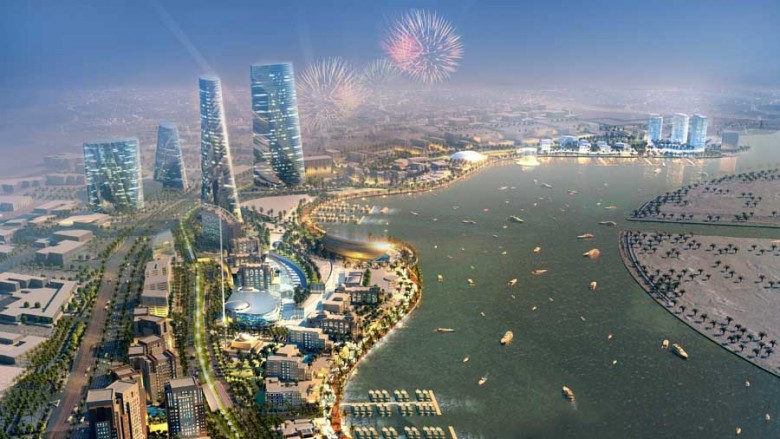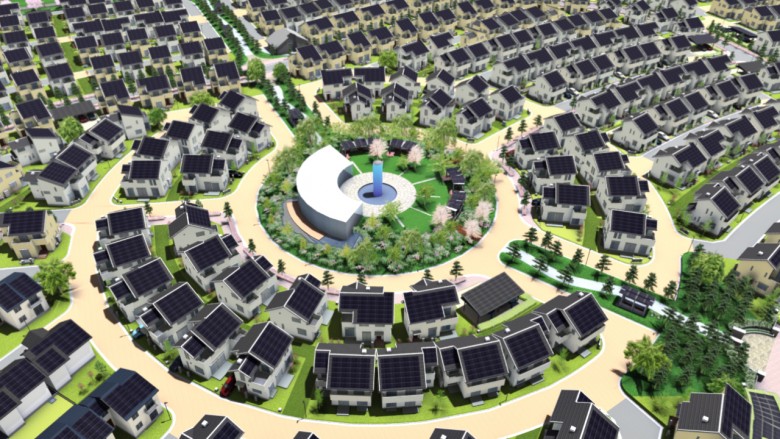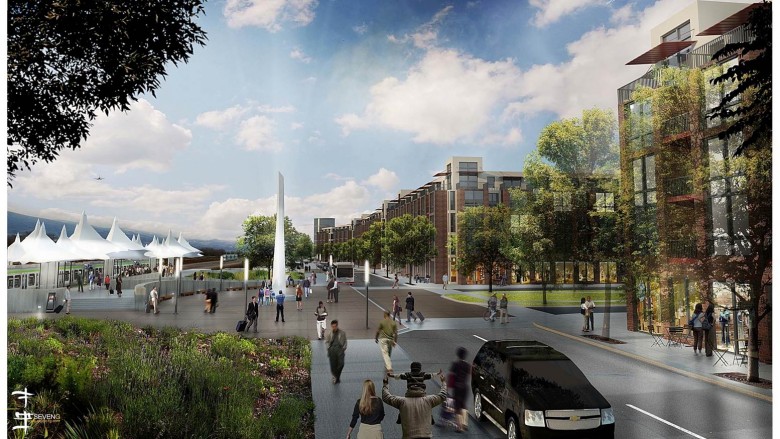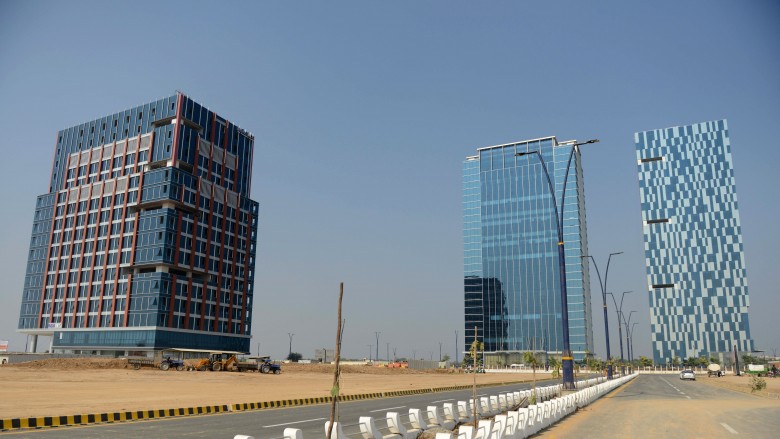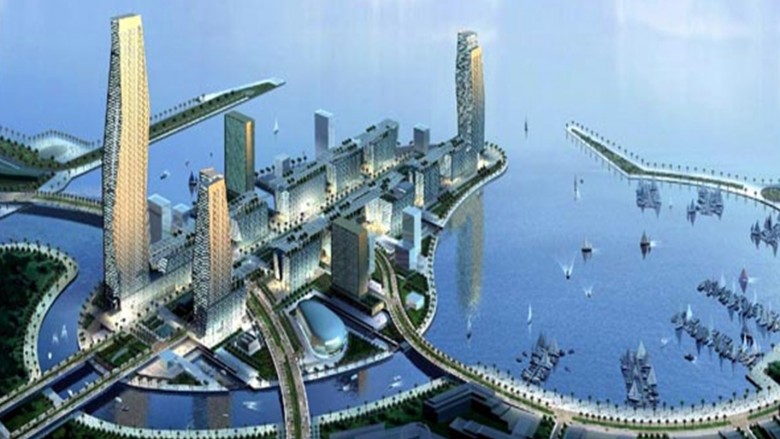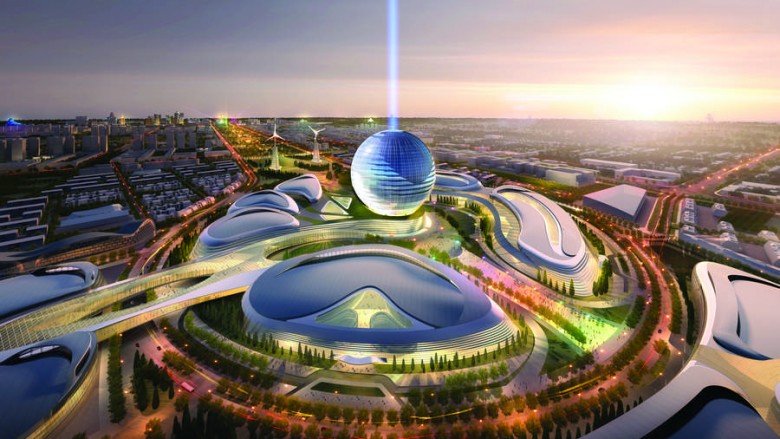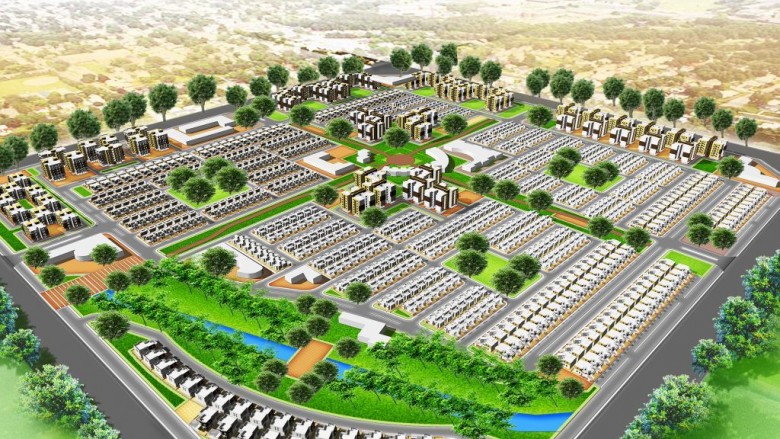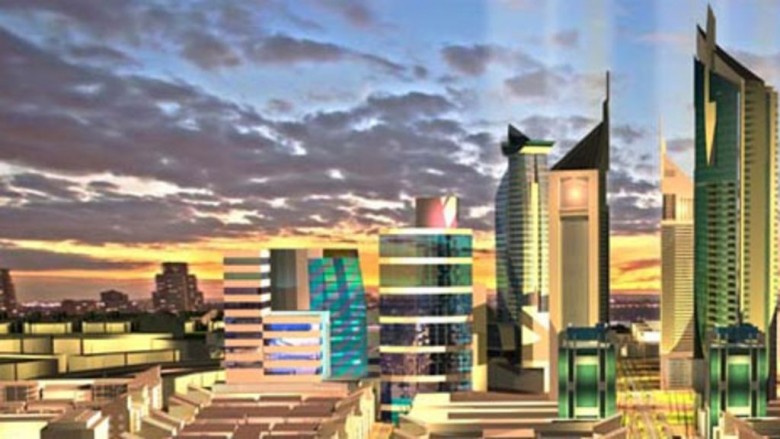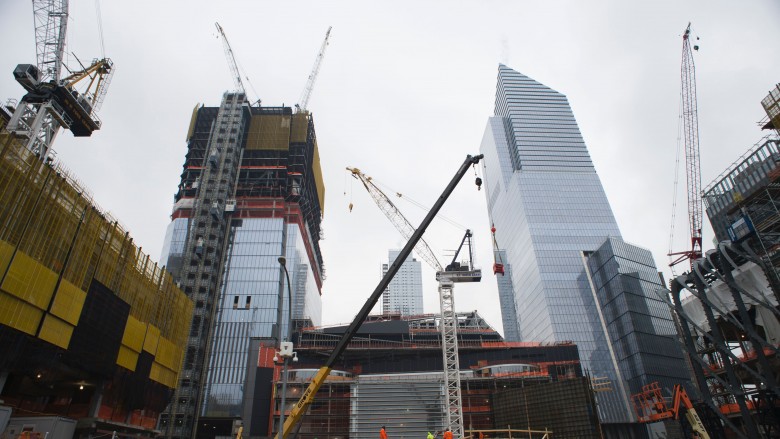Futuristic Cities Already Being Built
All over the world, new metropolises are being built with everything cool you could possibly think of, like state-of-the-art conveniences, high-tech utilities, and—fingers crossed—public bathrooms that are clean. These cities provide a snapshot of what our future will have in store for us, providing we don't, you know, die in a cyborg and/or zombie apocalypse in the meantime.
Lusail City, Qatar
In 2010, the oil-rich country of Qatar won the FIFA bidding process that gave it the right to host the 2022 World Cup. Rather than build on their own existing cities, they decided they it would be easier to build a brand new $45 billion dollar city instead, and thus Lusail City was born. Does it sound crazy to build an entire city in the middle of the desert in just 12 years? Of course it does, but Qatar has taken on the challenge and has so far been pretty successful in building what is supposed to be city for 450,000 people—which, by the way, is 200,000 more people than the entire population of Qatar itself.
Lusail City has several attractive advantages, including citywide integrated IT, a public transportation system to cut down on traffic problems, district cooling to combat the desert heat, and a pneumatic trash tube that will efficiently process all of the waste in the city. As a further middle figure to mother nature, an entire man-made waterway is being created by cutting off the westernmost top of the city to make Qetafian Island, which will serve as the main tourist center.
So far, the city has planned for just about everything, including an eHome service in private buildings that remotely controls heating and cooling, turning garden sprinklers on and off, and even the closing and shutting shutters. However, with all of this awesome stuff, there has to be human exploitation involved. Qatar allows employers to do pretty much whatever they want with the migrants building the city. One estimate says that as many as 4,000 workers could die by the 2022 World Cup, but remember this: these brave workers are giving up their lives so overpaid athletes can play soccer and the future citizens of Lusail City can be couch potatoes, so it's all worth it.
Fujisawa Sustainable Smart Town, Japan
Built on the site of a former factory, the Fujisawa Sustainable Smart Town was designed around green energy, a sense of community, and technologies straight out of The Jetsons. It is a $740 million town designed by tech giant Panasonic with the goal of being the coolest place ever. It was launched in 2014, and so far, around one thousand people live there. The town is supposed to be completed by 2020 and will house one thousand solar-powered homes, with the rest of the town fueled by a further 400 meters of solar panels surrounding it. Residents can even sell excess power and have the option of using hydrogen fuel cells, which sounds really sciencey, so it must be good.
The town uses a unique "gateless security system" that allows you the feeling of freedom when in actuality you're being monitored by a Big Brother network of 50 closed circuit cameras. There's just about everything for everyone: playgrounds, community centers, and a Wellness Square to dump your grandparents and kids at. Residents can use their smart TVs to coordinate package deliveries so the stupid postman doesn't conveniently arrive just as you're getting in the shower. A keypad controls the blinds, temperature settings, and lights. And there's a weather/disaster alert system. They even have electric cars available to rent to reduce dependency on fossil fuel vehicles, and the streetlights have sensors that save energy by only working when vehicles approach.
As perfect as the town sounds, it isn't perfect because ... uh, well, on second thought, maybe it is.
Pena Station Next
Pena Station Next is the American response to the Fujisawa Smart Town and is being built near Denver International Airport. Already a parking area covered with solar panels has been built in addition to a storage micro-grid. While Fujisawa is simply a smart community, Panasonic has described Pena Station Next as a "smart city lab" to test future technologies that will be incorporated into their smart city projects. Since Pena Station Next is in the outskirts of Denver, smart transit shelters have been designed for the most awesome transportation experience possible with features like LinkRay light technology that transmits data like transit schedules and even shopping deals to smartphones over light (it's probably witchcraft for all we know).
The houses there include even more wondrous acts of science like transparent TV screens that replace boring old windows, tabletops, and refrigerator doors. Another innovation is one that also comes from Japan: the sake fridge, which works to control different temperatures for different foods stored inside. Then there's the smart cooking counter that makes cooking a task you never really have to do again. With built-in cameras, the entire cooking process is monitored to prevent kitchen accidents and multi-purpose tables that allow you to charge your phones simply by placing them on the surface. Tools like the "Flat-Top Cooker" reheat anything you place on it. If you can think of it, this town has it, like smart street poles with security cameras topped by a device resembling a beehive that has been called a "FitBit for cities" and records everything from air particles to noise, temperature, and humidity.
Remember, this place is not made up, and its first 220 apartments should be done by mid-2018.
Gandhinagar, India
Gandhingar is actual a very old city but has recently been chosen to be the first city in India planned to be completely smart, and from what it has accomplished thus far, it seems better than most first-world cities. First of all, there are plans for blanket Wi-Fi throughout the entire city (so far, over 75 percent of the area has consistent Wi-Fi installed, with the remainder to be completed in the next few months). Then you have the various systems that watch and monitor just about everything. There are environmental sensors, an automatic number-plate recognition system, a public address system, a citizens' helpdesk application, and the list goes on. Of the 17,000 planned streetlights, 1,000 have already been installed, and they have sensors based on vehicular movements (a standard feature of futuristic cities apparently) saving an estimated 30 percent in energy use. All of this has been accomplished in the first phase of development—but wait, there's more!
Five digital signage cubes have been installed that serve as billboards for the public announcing weather reports and beaming government messages at the city's major intersections. India, a deeply religious country, has even incorporated devotional music into the city's design by installing PA systems in 13 zones of the city to play early in the morning. Later, they'll work to spread various announcements throughout the day. In the future, there will be 30 sectors of the city with all of these features and more, but most importantly, there will be that all-encompassing Wi-Fi because without it, citizens would have to gasp talk to each other.
King Abdullah Economic City, Saudi Arabia
Saudi Arabia is a magical place where oil money has allowed its wealthiest citizens to build cities deliberately designed to look as whimsical as possible. The King Abdullah Economic City (abbreviated as KAEC, pronounced as "cake," which sounds pretty good right now) is just the latest of these sci-fi utopias being built in the barren wasteland. The city, first announced in 2005, has been designed with the future in mind. Specifically, a future when the oil that so far rules the country runs out. In fact, plans for the city include electric cars for its citizens free of charge to cut down on carbon emissions. Plus, there are even plans for a driverless car system that will be a solution for the whole "women aren't allowed to drive in Saudi Arabia" problem.
When the city is completed by 2035, it will serve as both a major port and an intermediary between two of Saudi Arabia's most important holy cities, Medina and Mecca, so it's not like they're building a random city in the middle of nowhere. The city will cost some $100 billion dollars, which is a lot even for the ultra-rich ruling class of the country, so they're banking a lot on the city's success even as oil prices fall worldwide.
One of the biggest components used to make the city the most advanced in the Middle East is automation through the Internet of Things, which makes pretty much everything in the city work for you at your command like your very own genie (the analogy works, since it's Saudi Arabia, you know). While there have been setbacks, Fahd Al-Rasheed, the managing director of the KAEC project, has said that the population grew by 70 percent by this year, which means the city has seen some success despite stumbling blocks.
Astana Expo City, Kazakhstan
Kazakhstan is one of those central Asian nations that you'd think is made up if you didn't know any better, but it is home to one of the most futuristic cities in the world: Astana, the capital. Astana is also the host city for the 2017 World Expo with the theme of "Future Energy," and they're facing this task head-on by setting aside 429 acres to build a literal "city of the future." At the center is the planned Kazakhstan Pavilion. This building, designed to look like a glittering disco ball of the future, is being built with an advanced "skin" to prevent heat from escaping the structure and reduce solar glare on the inside. Already this place sounds like an alien city out of Star Trek, but impressive real technologies are at work.
The city is being built with an integrated smart grid that will allow "an inter-seasonal underground thermal energy storage," solar panels, and wind turbines to power the area. 100 percent of rainwater will be managed and reused for the city's water supply. In addition, every building in the expo city works overtime by doubling as power plants, while high-tech glazing conserves heat during the winter, and shading during the summer will further conserve energy. So if you want a true picture of what the future has in store for us, look no further than Astana, which most of you probably had never heard of up until this moment.
Naya Raipur, India
Following the example of Gandhinagar, Naya Raipur is another of India's up-and-coming smart cities and is even more impressive than its predecessor. For instance, India has long had a problem with sewage and waste management, so the developers of Naya Raipur designed a system that would make it India's first "zero sewage discharge city" because as we all know, you can't have a city of the future if it has the sewage system of medieval London. It also holds the prestigious title of the world's first "integrated city" using a "Master System Integrator" to effectively manage the city's inner workings by collecting intelligence and assessing the best possible solutions for whatever problem arises. That sounds an awful lot like Skynet from Terminator, but it's more digital civil servant than dystopian A.I. Overlord.
Rather than rush and hastily build infrastructure, the designers have chosen to gradually develop its amenities so they can see what best fits the inhabitants and have so far been quite successful. In a country where the vast majority of the population has little to no access to healthcare, Naya Raipur has developed a state-of-the-art medical community for its citizens, including specialty cancer and heart centers. There's even an effort to making learning fun, which sounds incredibly corny until you look into the city's efforts that include knowledge parks and accessible education centers. That's way better than the rest of the world where education is whatever you manage to remember in between doodling and daydreaming. The city is a giant wonderland that you'd never want to leave from now until the Master System decides to annihilate us all.
Konza Techno City, Kenya
Konza Techno City—which sounds more like an EDM dance mix than the name of a future technology hub—has been dubbed the "Savannah Silicon Valley" for its bold goal of becoming the most innovative city in Africa. We may not think Africa is really known for being high-tech, but Konza Techno City could change all of that by creating a gleaming digital utopia on the safari. First announced in 2013, it has a $14.5 billion price tag, but you know what they say: you pay for quality, and that includes the best amenities and technology the world has to offer. Most of Kenya has needed improvements on infrastructure for decades, and Konza is supposed to be the answer as the country makes its way into the 21st century.
The city is being built in four phases, and after a few delays finally broke ground last year in March with an administrative headquarters to oversee the rest of the development of the city. Then last month, the city reached another milestone when fiber link cables were connected to the city, making it one of the most digitally connected areas in Africa. Like KAEC in Saudi Arabia, Konza has taken up the concept of Internet of Things by using our future machine masters to create an efficient system to run the city. Already, there's a lot of interest in the city because several prestigious technical schools like the Korean Advanced Institute of Science and Technology have announced plans to build campuses in Konza. That shows that there's plenty of confidence in the future of this former nowhere in the middle of Africa.
Hudson Yards Smart City, New York
Hudson Yards is the largest real estate development in the United States and is being built on a platform completely covering its namesake—one of the busiest railways in the world, the Hudson Railyards. This area will have quite possibly the most high-tech smart city in the United States with brand-new skyscrapers, parks controlled by cutting edge green technologies, and, hopefully, no schlocky tourist stands clogging its streets. The platform is held up by giant custom-made columns that will allow the city to be built without worrying about it collapsing onto the bustling train systems below.
One of the main structures of the city is the CoGen plant that will produce 70 percent of its energy needs, making it almost entirely self-sufficient. Since the energy is being produced on-site, none of the future residents of Hudson Yards will have to worry about weather or any other unforeseen disasters knocking the power out. Then you have sensors that will cut down on energy consumption by closely monitoring the city's output so nothing is wasted, and air quality data collection will determine how clean the air is based on asthma hospitalizations, so you won't have to worry about going outside like you would in New York City where the atmosphere is usually kind of gross.
Another plus is that most of the data that be gathered on a voluntary basis, which is reassuring considering the government is probably watching you right now as you're reading this. And what about those cutting edge parks? Jet engines and ventilation will allow the soil to be kept at optimal temperature by stopping the heat from rising from the trains running below. A 60,000-gallon water tank will collect rainwater to irrigate the parks, saving water and cutting down on costs.
The first skyscraper was completed last year, and the remainder of the first phase of development should be completed by 2019, so there you have it: the future is out there. Let's just hope this future isn't also filled with death machines or violent aliens from outer space.

